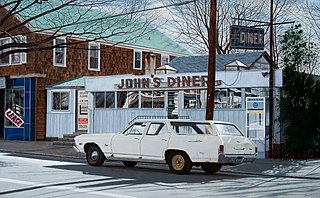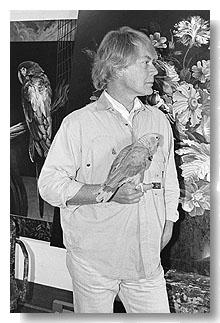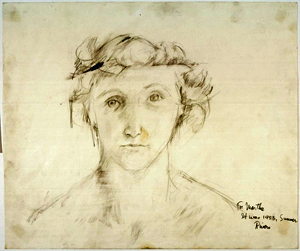Related Research Articles

Mount Clemens is a city in the U.S. state of Michigan. The population was 15,697 at the 2020 census. It is the seat of government of Macomb County.

Photorealism is a genre of art that encompasses painting, drawing and other graphic media, in which an artist studies a photograph and then attempts to reproduce the image as realistically as possible in another medium. Although the term can be used broadly to describe artworks in many different media, it is also used to refer specifically to a group of paintings and painters of the American art movement that began in the late 1960s and early 1970s.

Ian Hornak was an American draughtsman, painter and printmaker. He was one of the founding artists of the Hyperrealist and Photorealist fine art movements; credited with having been the first Photorealist artist to incorporate the effect of multiple exposure photography into his landscape paintings; and the first contemporary artist to entirely expand the imagery of his primary paintings onto the frames.
College for Creative Studies (CCS) is a private art school in Detroit, Michigan. It enrolls more than 1,400 students and focuses on arts education. The college is also active in offering art education to children through its Community Arts Partnerships program and its Henry Ford Academy: School for Creative Studies.

Martin Johnson Heade was an American painter known for his salt marsh landscapes, seascapes, and depictions of tropical birds, as well as lotus blossoms and other still lifes. His painting style and subject matter, while derived from the romanticism of the time, are regarded by art historians as a significant departure from those of his peers.

Paul Rosenberg was a French art dealer. He represented Pablo Picasso, Georges Braque and Henri Matisse. Both Paul and his brother Léonce Rosenberg were among the world's major dealers of modern art.

Marshall Maynard Fredericks was an American sculptor known for such works as Fountain of Eternal Life, The Spirit of Detroit, Man and the Expanding Universe Fountain, and many others.

Hyperrealism is a genre of painting and sculpture resembling a high-resolution photograph. Hyperrealism is considered an advancement of photorealism by the methods used to create the resulting paintings or sculptures. The term is primarily applied to an independent art movement and art style in the United States and Europe that has developed since the early 1970s. Carole Feuerman is the forerunner in the hyperrealism movement along with Duane Hanson and John De Andrea.
Thomas Leo Blackwell was an American hyperrealist of the original first generation of Photorealists, represented by Louis K. Meisel Gallery. Blackwell is one of the Photorealists most associated with the style. He produced a significant body of work based on the motorcycle, as well as other vehicles including airplanes. In the 1980s, he also began to produce a body of work focused on storefront windows, replete with reflections and mannequins. By 2012, Blackwell had produced 153 Photorealist works.
Lowell Blair Nesbitt was an American painter, draughtsman, printmaker, and sculptor. He served as the official artist for the NASA Apollo 9, and Apollo 13 space missions; in 1976 the United States Navy commissioned him to paint a mural in the administration building on Treasure Island spanning 26 feet x 251 feet, then the largest mural in the United States; and in 1980 the United States Postal Service honored Lowell Nesbitt by issuing four postage stamps depicting his paintings.

Edith Halpert or Edith Gregor Halpert was a pioneering New York City dealer of American modern art and American folk art. She brought recognition and market success to many avant-garde American artists. Her establishment, the Downtown Gallery, was the first commercial art space in Greenwich Village. When it was founded in 1926, it was the only New York gallery dedicated exclusively to contemporary American art by living artists. Over her forty-year career, Halpert showcased such modern art luminaries as Elie Nadelman, Max Weber, Marguerite and William Zorach, Stuart Davis, Peggy Bacon, Charles Sheeler, Marsden Hartley, Yasuo Kuniyoshi, Ben Shahn, Jack Levine, William Steig, Jacob Lawrence, Walter Meigs, Arthur Dove, John Marin, Georgia O'Keeffe, and many others. Halpert later expanded her business to include American folk art, and certain nineteenth-century American painters, including Raphaelle Peale, William Michael Harnett, and John Frederick Peto, whom she considered to be precursors to American modernism.
Louis K. Meisel is an American author, art dealer and proponent of the photorealist art movement, having coined the term in 1969. He is also the owner of one of the earliest art galleries in SoHo at 141 Prince Street. In addition to Photorealism, Meisel is responsible for the resurgence of interest in the sub-set of American illustration identified as "Pin-up", and is the largest collector of original art of both genres. Louis and Susan Meisel own the largest collections of Photorealism and pin-up art in the world.
Susan Tepper was an American Neo-Expressionist and Figurative painter.
Dante Raphael Giglio, better known as Giglio Dante, was an Italian-born American painter.

Eric Ian Hornak-Spoutz is an American art dealer, historian and museum curator. Spoutz has owned art galleries in Detroit, Michigan, Cape Coral, Florida, Palm Beach, Florida, and Los Angeles, California.
Julius Rosenthal Wolf (1929–1976) was an American casting director, producer, theatrical agent, art collector, art dealer, and the vice president of General Amusement Corporation, then the second largest talent management agency in the world.

Martha Jackson was an American art dealer, gallery owner, and collector. Her New York City based Martha Jackson Gallery, founded in 1953, was groundbreaking in its representation of women and international artists, and in establishing the op art movement.
Rosemary Ellen Rutherford was a British artist notable for her paintings and stained glass designs.
References
- ↑ Tom Watts, "Harrison Township art dealer is quick study," Macomb Daily, Feb. 15, 2012
- 1 2 Jameson Cook, "Dual depictions presented of a prominent art dealer gone bad," Macomb Daily, Feb. 14, 2017
- 1 2 Stephen Bennett Phillips, "Ian Hornak Transparent Barricades," exhibition catalogue, Board of Governors of the Federal Reserve System, Fine Art Program, Washington D.C., 2012
- ↑ Ken Johnson, "Ian Hornak, 58, Whose Paintings Were Known for Hyper-Real Look," New York Times, December 30, 2002
- 1 2 3 4 5 Slivka, Rose (December 2, 1993). "From the Studio". The East Hampton Star. p. II-7.
- 1 2 Patsy, Southgate (November 20, 1997). "Ian Hornak: Creating An Art Apart". The East Hampton Star.
- ↑ Marci Creps, "On Exhibit: Jan 19, 2014" Hoosier Times, Jan. 19, 2014
- ↑ Maryanne MacLeod, "Art Center showcases revolutionary exhibit: Nationally celebrated Ian Hornak retrospective," Macomb Daily, Jun. 26, 2014